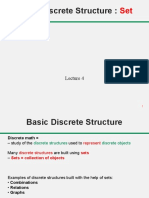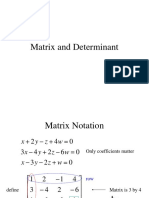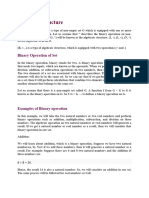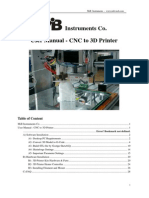0 ratings0% found this document useful (0 votes)
499 viewsApplication of Discrete Math in Real Life
Discrete mathematics is the study of mathematical structures that are countable or distinct. It is essential in fields like cryptography, databases, logistics, and computer algorithms. Cryptography relies on discrete math concepts like number theory to create secure passwords. Relational databases use sets to organize discrete pieces of information and link them together. Logistics employs graph theory from discrete math to model networks and determine optimal routes. Computer algorithms are designed using discrete math to maximize efficiency and speed.
Uploaded by
MD: Rabiul Awal ShuvoCopyright
© © All Rights Reserved
Available Formats
Download as PDF, TXT or read online on Scribd
0 ratings0% found this document useful (0 votes)
499 viewsApplication of Discrete Math in Real Life
Discrete mathematics is the study of mathematical structures that are countable or distinct. It is essential in fields like cryptography, databases, logistics, and computer algorithms. Cryptography relies on discrete math concepts like number theory to create secure passwords. Relational databases use sets to organize discrete pieces of information and link them together. Logistics employs graph theory from discrete math to model networks and determine optimal routes. Computer algorithms are designed using discrete math to maximize efficiency and speed.
Uploaded by
MD: Rabiul Awal ShuvoCopyright
© © All Rights Reserved
Available Formats
Download as PDF, TXT or read online on Scribd
You are on page 1/ 3
Application of Discrete Math In real Life
What is Discrete Math: Discrete mathematics is the study of mathematical
structures that are countable or otherwise distinct and separable. Examples
of structures that are discrete are combinations, graphs, and logical
statements. Discrete structures can be finite or infinite.
Discrete Math in Cryptography: The field of cryptography, which is the
study of how to create security structures and passwords for computers and
other electronic systems, is based entirely on discrete mathematics. This
is partly because computers send information in discrete -- or separate and
distinct -- bits. Number theory, one important part of discrete math,
allows cryptographers to create and break numerical passwords. Because of
the quantity of money and the amount of confidential information involved,
cryptographers must first have a solid background in number theory to show
they can provide secure passwords and encryption methods.
Relational Databases: Relational databases play a part in almost every
organization that must keep track of employees, clients or resources. A
relational database connects the traits of a certain piece of information.
For example, in a database containing client information, the relational
aspect of this database allows the computer system to know how to link the
client’s name, address, phone number and other pertinent information. This
is all done through the discrete math concept of sets. Sets allow
information to be grouped and put in order. Since each piece of information
and each trait belonging to that piece of information is discrete, the
organization of such information in a database requires discrete
mathematical methods.
Uses for Discrete Math in Logistics: Logistics is the study of organizing
the flow of information, goods and services. Without discrete mathematics,
logistics would not exist. This is because logistics makes heavy use of
graphs and graph theory, a sub-field of discrete math. Graph theory allows
complex logistical problems to simplify into graphs consisting of nodes and
lines. A mathematician can analyze these graphs according to the methods of
graph theory to determine the best routes for shipping or solving other
logistical problems.
Computer Algorithms: Algorithms are the rules by which a computer
operates. These rules are created through the laws of discrete mathematics.
A computer programmer uses discrete math to design efficient algorithms.
This design includes applying discrete math to determine the number of
steps an algorithm needs to complete, which implies the speed of the
algorithm. Because of discrete mathematical applications in algorithms,
today’s computers run faster than ever before.
Symbols: Common Symbols Used in Set Theory, Symbols save time and space
when writing. Here are the most common set symbols.In the examples C =
{1,2,3,4} and D = {3,4,5}
You might also like
- Instant Download Solid Geometry 1st Edition N. P. Bali PDF All Chapters100% (9)Instant Download Solid Geometry 1st Edition N. P. Bali PDF All Chapters67 pages
- Lab 5 Configuring Security Policy Rules and NAT RulesNo ratings yetLab 5 Configuring Security Policy Rules and NAT Rules51 pages
- Programme Project Report (PPR) of Master of Science (Mathematics) M.Sc. (Mathematics)No ratings yetProgramme Project Report (PPR) of Master of Science (Mathematics) M.Sc. (Mathematics)23 pages
- Download Full Discrete Mathematics Special Indian Edition Semyour Lipschutz PDF All Chapters100% (8)Download Full Discrete Mathematics Special Indian Edition Semyour Lipschutz PDF All Chapters77 pages
- NumericalMethodsT264UnitIIIByDrNVNagendram PDFNo ratings yetNumericalMethodsT264UnitIIIByDrNVNagendram PDF60 pages
- Elements of Sets and Logic Lecture Manal by Chebet Eli100% (1)Elements of Sets and Logic Lecture Manal by Chebet Eli18 pages
- IJAMSS - Group Action On Picture Fuzzy Soft G-Modules - 1 - 1No ratings yetIJAMSS - Group Action On Picture Fuzzy Soft G-Modules - 1 - 118 pages
- Uses of Graph Theory in Day To Day Life: Veena RaniNo ratings yetUses of Graph Theory in Day To Day Life: Veena Rani6 pages
- Discrete Mathematics 4th Edition B. S. Vatsa download pdf100% (3)Discrete Mathematics 4th Edition B. S. Vatsa download pdf72 pages
- Cantor Set in Measure Theory: An-Najah National University Faculty of Graduate StudiesNo ratings yetCantor Set in Measure Theory: An-Najah National University Faculty of Graduate Studies53 pages
- Boolean Near Rings and Weak CommutativityNo ratings yetBoolean Near Rings and Weak Commutativity6 pages
- International Islamic University, Islamabad BS Mathematics Real Analysis IINo ratings yetInternational Islamic University, Islamabad BS Mathematics Real Analysis II29 pages
- Discrete Mathematics - Chapter 7 Posets Lattices & Boolean AlgeNo ratings yetDiscrete Mathematics - Chapter 7 Posets Lattices & Boolean Alge82 pages
- Applications of Complex Analysis in Various FieldsNo ratings yetApplications of Complex Analysis in Various Fields5 pages
- Introduction To MCDM Techniques: AHP As Example: August 2019No ratings yetIntroduction To MCDM Techniques: AHP As Example: August 201942 pages
- Hesitant Fuzzy Set and Its Extensions: December 2017No ratings yetHesitant Fuzzy Set and Its Extensions: December 201737 pages
- Christy's Classes - Average and MixturesNo ratings yetChristy's Classes - Average and Mixtures58 pages
- G. Hadley - Linear Programming.-addison-Wesley Publishing (1962)No ratings yetG. Hadley - Linear Programming.-addison-Wesley Publishing (1962)532 pages
- Direct Products of Groups and The Fundamental Theorem of Finite Abelian GroupsNo ratings yetDirect Products of Groups and The Fundamental Theorem of Finite Abelian Groups41 pages
- Real Analysis by R. Vittal Rao: Lecture 1: March 01, 2006100% (1)Real Analysis by R. Vittal Rao: Lecture 1: March 01, 20063 pages
- (Golden Maths Series) N.P. Bali-Real Analysis-FirlNknlknewall Media (2005)100% (1)(Golden Maths Series) N.P. Bali-Real Analysis-FirlNknlknewall Media (2005)420 pages
- Equity of Cybersecurity in the Education System: High Schools, Undergraduate, Graduate and Post-Graduate Studies.From EverandEquity of Cybersecurity in the Education System: High Schools, Undergraduate, Graduate and Post-Graduate Studies.No ratings yet
- Application of Discrete Math in Real LifeNo ratings yetApplication of Discrete Math in Real Life11 pages
- Construction Equipment: Amrutha K 4SN16AT006 Sem Viii Sec ANo ratings yetConstruction Equipment: Amrutha K 4SN16AT006 Sem Viii Sec A25 pages
- Hyundai Service Guide Diesel and LPG 7 Range100% (42)Hyundai Service Guide Diesel and LPG 7 Range10 pages
- NT990 Bridge Navigational Watch Alarm System (BNWAS) : Navitron Systems LTDNo ratings yetNT990 Bridge Navigational Watch Alarm System (BNWAS) : Navitron Systems LTD3 pages
- SAP ACE Add-On - Amortization of AccrualsNo ratings yetSAP ACE Add-On - Amortization of Accruals7 pages
- Good Practice in Undergraduate EducationNo ratings yetGood Practice in Undergraduate Education17 pages
- Advanced View of Atmega Microcontroller Projects List - Projects Tutorials Code Library For Atmels Atmega32 AVRNo ratings yetAdvanced View of Atmega Microcontroller Projects List - Projects Tutorials Code Library For Atmels Atmega32 AVR178 pages
- A Hybrid Active Filter For Damping of Harmonic Resonance in Industrial Power SystemsNo ratings yetA Hybrid Active Filter For Damping of Harmonic Resonance in Industrial Power Systems9 pages
- Introducing Coresight: Debug and Trace Infrastructure: Non-ConfidentialNo ratings yetIntroducing Coresight: Debug and Trace Infrastructure: Non-Confidential25 pages
- PDF Blockchain, Big Data and Machine Learning: Trends and Applications First Edition Kumar DownloadNo ratings yetPDF Blockchain, Big Data and Machine Learning: Trends and Applications First Edition Kumar Download53 pages
- ISO - 9445 - 1 - 2009 - Continuously Cold-Rolled Stainless Steel Tolerances On Dimensions and Form Part 1-Narrow Strip and Cut LengthsNo ratings yetISO - 9445 - 1 - 2009 - Continuously Cold-Rolled Stainless Steel Tolerances On Dimensions and Form Part 1-Narrow Strip and Cut Lengths6 pages

























































































